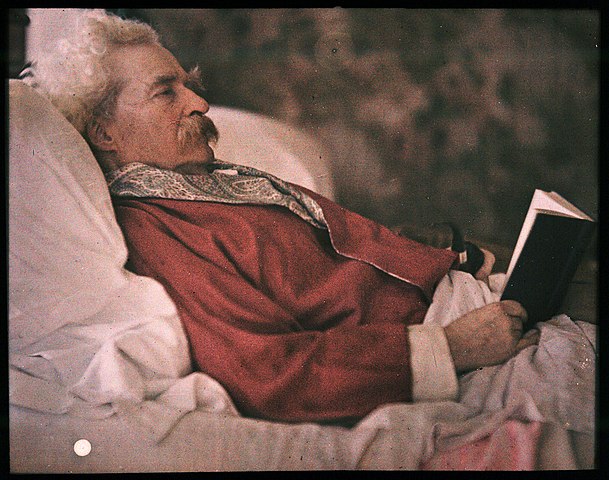Author Bibliography (in progress)
Twain, Mark (Samuel Clemens, 1835-1910)
BIOGRAPHICAL NOTE
 Samuel Langhorne Clemens (Mark Twain) was born on 30 November 1835 in Florida, Missouri, and died on 21 April 1910 at Stormfield House in Redding, Connecticut. He worked as a printer, river pilot, miner, journalist, humorist, publisher, novelist, and lecturer. Through his wife's connections, he formed a strong friendship with William Dean Howells, and met such reformers as Frederick Douglass and Harriet Beecher Stowe, who became his neighbor when the Twain family moved to Hartford, Connecticut, in 1873. Clemens was a supporter of Abolition and women's suffrage; later in life he was an outspoken opponent of US imperialism in the Pacific and he served as Vice-President of the Anti-Imperialist League of New York from 1901 until his death.
Samuel Langhorne Clemens (Mark Twain) was born on 30 November 1835 in Florida, Missouri, and died on 21 April 1910 at Stormfield House in Redding, Connecticut. He worked as a printer, river pilot, miner, journalist, humorist, publisher, novelist, and lecturer. Through his wife's connections, he formed a strong friendship with William Dean Howells, and met such reformers as Frederick Douglass and Harriet Beecher Stowe, who became his neighbor when the Twain family moved to Hartford, Connecticut, in 1873. Clemens was a supporter of Abolition and women's suffrage; later in life he was an outspoken opponent of US imperialism in the Pacific and he served as Vice-President of the Anti-Imperialist League of New York from 1901 until his death.
While Mark Twain's writing promotes such carnist behaviors as hunting. fishing, and meat-eating, his work is also, and significantly, characterized by his staunch opposition to animal cruelty and a consistent return to the themes of anti-anthropocentrism and animal rights based on the communicative, intellectual, and natural abilities of non-human animals. Twain’s human characters are frequently critiqued through their (mis)treatment of animals and humanity as a species is frequently characterized as being the “lower animal” in comparison to others due to cruelty and greed. His stories “The Victims” and “A Dog’s Tale” make reference to the slave trade: in “The Victims” slavery is used to criticize humanity in contrast to animals; in “A Dog’s Tale,” the dog describes being sold away from his mother with no recourse and barely time to say goodbye forever. Slavery as a critique of humanity appears in numerous other texts as well. However, it was the increasingly widespread practice of vivisection that prompted Twain's loudest calls for animal rights. His 1899 letter to the London Anti-Vivisection Society, reprinted as The Pains of Lowly Life, was published and circulated on both sides of the Atlantic and his story, “A Dog’s Tale” published in Harper’s Magazine (1903) consolidated his status as a spokesperson for the anti-vivisection cause.
IMAGE: Alvin Langdon Coburn, 1908. Public domain, via Wikimedia Commons
PUBLICATIONS
Letters of Mark Twain: Complete. Ed. Albert Bigelow Paine. London: Chatto and Windus, 1920.
Mark Twain’s Book of Animals. Ed. Shelley Fisher Fishkin. Berkeley and Los Angeles: University of California Press, 2010.
Mark Twain's Notebook, 1835-1910. Ed. Albert Bigelow Paine. New York: Cooper Square Publishers, 1972.
https://archive.org/details/marktwainsnotebo0000twai_q3r3/page/n7/mode/2up
Mark Twain’s Notebooks: Journals, Letters, Observations, Wit, Wisdom, and Doodles. Ed. Carlo Devito. New York: Black Dog & Leventhal, 2015.
The Pains of Lowly Life. London, 1900. Rpt. Mark Twain on Vivisection. British Union for the Abolition of Vivisection, Office of Melbourne Branch, Essendon Gazette Print, n.date.
Selected Mark Twain-Howells Letters, 1872-1910. Ed. Frederick Anserson, William Merriam Gibson, Henry Nash Smith. Cambridge, Mass.: Belknap Press of Harvard University Press, 1967.
Last updated on July 23rd, 2024
SNSF project 100015_204481
@VLS@veganism.social | VeganLiteraryStudies | @veganliterarystudies | @vegan_lit_studies
